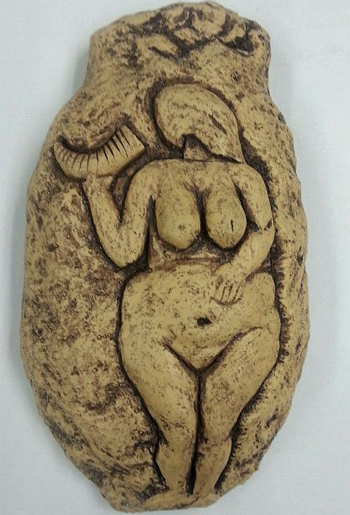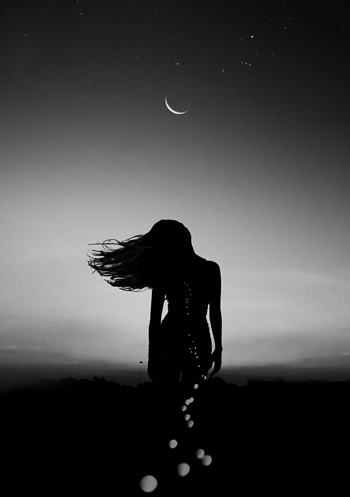Connection between woman and the moon
A man by the name of Alexander Marshack, in the 1960s found a piece of bone near the headwaters of the Nile. The bone was close to 30,000 years old. But its age however, was not the most interesting feature. What made this bone particularly unusual is that it had, at periodic intervals, notches carved into it as if to mark a sequence of time. He later found many other such markings on bones, antlers, stones and goddess figures, in Czechoslovakia, Russia, Spain and Italy.

After studying these numerous finds, Marshack was convinced that the lines were not made all at once as if to somehow decorate the object, but were made at different times as one would find with any crude calendar. His theory is that these objects were the first attempts at keeping a record of time, and that these markings were actually indications of lunar cycles.
This idea was quite shocking to his academic friends. For it implied a degree of mental sophistication on the part of our early ancestors, that no one had yet imagined. But then something else turned up, something that uncovered their eyes and pulled back the curtain. It is a solitary carving in rock about 17 inches high, discovered in France. Its age has been estimated between 24,000 to 20,000 years old. It is a female figure standing upright. She is holding elevated in her right hand a bison’s horn – crescent-shaped like the New Moon. The horn is notched with thirteen lines.
These mysterious thirteen lines became the centre of much discussion. Eventually, they came to be understood to indicate either the thirteen days from the visible New Moon to the Full, or the thirteen New Moons of each yearly cycle.
Most astounding about this carving, however, is something graphically indicated by her left hand. She is resting her left hand upon her swelling womb, showing all to see in no uncertain terms, a relationship between the cycles or phases of the Moon and the cycles of the womb. In this figure, the mystery and power of the celestial realms have become graphically infused and embodied in the female form.
This mysterious unity of the celestial and the terrestrial realms personified in the female is certainly the most powerful and long lasting religious image ever to evolve in the human species. And in fact, it is still with us today. Go into any Catholic church and look closely at the image of the mother of Jesus. She will be found to be standing on the crescent Moon.
If we take off our glasses of the twentieth century and peer out into the darkness of our past, there is one image that dominates the night as no other – the Moon. Her ever changing phases, yet ever renewing cycles captured the imagination of the human mind like no other image. And with her mysterious motions she wove the fabric of many myths and rituals all over the World.
At some point in our evolutionary journey, the Moon became the universal image of the feminine energy. The Moon not only governed the tides of the sea, but also the tides of the womb. The menstrual cycle coincides with the 28 day cycle of the Moon. Even today, in many parts of the world women still refer to their menstrual cycle as being their “moon time”.
It is not surprising then, to find that all early calendars were based on this primary association between the cycles of menstruation and the phases of the Moon. In many languages, the words for Moon, month, measurement and menstruation have either similar meanings or common root words. In Gaelic for example, the words for “menstruation” and “calendar” are the same. Similar associations are seen all over the world.
A month was measured from one New Moon to the next, giving 13 New Moons for each year. Consequently, all early calendars had thirteen months in the year. Every festival was calculated to the New or Full Moons. And in many parts of Europe, people continued observing these ancient festivals well into the Middle Ages.
The calendar then, was not some distant abstraction to these people, but something that gave meaning and structure to their lives in ways we can scarcely imagine. It was a paradigm that was woven with the threads of their own biology and spiritual perceptions. It was a reality that recognized the seasons of increase and decrease, of birth and death as rhythmic phases in a larger, ever renewing cycle. Nothing was perceived in terms of absolute opposites, only as complementary cycles in the spiral dance of Creation.

In the Northern latitudes the New Moon became associated with spring, birth, and the growth of all living things. This image was similarly represented in the life of the female as the maiden or young girl.
Associated with the Full Moon was summertime, when all life became fruitful. This phase of the Moon naturally became symbolic of motherhood.
The waning or decreasing Moon was associated with winter, when the Earth became less abundant. It also became associated with the female who ceased to flow her life-giving blood. Because she now retained the sacred blood of life, the older woman was regarded to be more powerful and wise. For this reason, in many societies the elder women were always the centre of power.
So we find this mysterious relationship between the three phases of the Moon, the seasonal rhythms of the Earth, and the three stages in a woman’s life, symbolically depicted in the lunar image of the female. She represented the primary image that influenced nearly all concepts of deity for at least 20,000 years.
Each of these three lunar aspects eventually became personified as a separate goddess.
In Greece, the three goddesses were known as Athene, Aphrodite and Hecate. In Ireland they were known as Ana, Babd and Macha; and in India as Parvati, Durga and Uma.
Through these kinds of associations we are still able to get a small glimpse of the once universally recognized bond between the concepts of deity, the Moon and females. The lunar cycles became the basis of all ancient calendars, which in turn became the governing principle for almost all activities of early societies, especially those activities centred around agriculture. Even today in many parts of the world, the cycles of the Moon are considered when planting or harvesting food crops. The Farmer’s Almanac still associates times of planting with the cycles of the Moon.
Because of their mysterious association with the Moon, women were quite naturally seen to be the leaders of the tribe, clan or social structure. Their biological processes were perceived in a spiritual context, whereby women became the natural power holders, the initiators of the species.
In the ancient and almost universal culture, women didn’t dominate men as in the later societies where men had absolute power over women. We do not find any indications of a pyramid social structure, or hierarchy dominated by a woman or a group of women who gathered most of the wealth and power for themselves, leaving the rest of the society fighting over the crumbs, as we repeatedly find in the later societies ruled exclusively by male hierarchies. Rather, we find cooperative communities where the primary ethic was based on sharing, the sharing of food, natural resources and work.
By every indication these early communities sought to live in harmony with the organic and cyclic processes of nature, rather than to dominate or exploit their environment, a process that begins to be so typical in the later Bronze Age developments. One other feature that was conspicuously absent from these early communities, is any sign of violence. We find in their extensive artwork no indication of any symbols of domination – spears, swords, or thunderbolts that we find in later societies, where the ruler or deity demands obedience under the threat of killing or violence. Rather the emphasis was on bonding, reinforcing the primal connection with the Source of Life and the cooperation between all life forms.
yogaesoteric
July 14, 2019
